Trousers
Quantity of Fabric
A pair of trousers will require about 1¼ yards of 58-60" fabric if there is no gusset, or about 1½ yards if there is to be a gusset.
Length and Fit
Trousers should be long enough to tuck into the shoes. The trousers can be fairly loose on the thighs, although they should be tight fitting on the lower leg.
Some trousers have an integral foot. The two legs can be joined directly to each other, or they can have a gusset between the legs. If your trousers/hose ride up then a simple cloth strap (like with ski pants) can be sewn onto the base of the trousers. If you are going to wear modern socks, then the trousers should cover these - either going into or over the trousers.
How to make a simple pair of trousers.
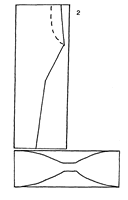
 Fold the fabric into four as shown in the diagram.
Fold the fabric into four as shown in the diagram.
Cut the legs of the trousers out as shown (follow the dotted line if there is to be a gusset). Make the legs slightly wider than you think they need to be. They can then be pinned to fit as tightly as possible, but make sure that you can still get your foot out! If you are wearing trousers then you will probably also be wearing leg bindings - if necessary you can leave the bottom seam of the trousers open to allow your foot to go through the gap and then hold this in place with the leg bindings.
The waist band needs to be 2-3" above the waist.
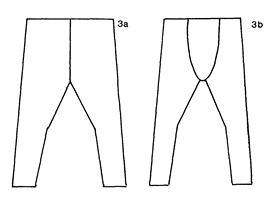 Sew up the
inside leg of both legs. Then join the two legs at the crotch (3a) or sew in
the gusset (3b).
Sew up the
inside leg of both legs. Then join the two legs at the crotch (3a) or sew in
the gusset (3b).
Turn over the waist band and stitch down to form a tube open at the centre front. You should have left enough cloth to have a high waistband. Pull the trousers on comfortably, put a belt/tie around your waist at a comfortable position and fold the waistband over. Mark this with chalk or pin. Now you can sew the band in place. Make sure that the crotch is not too tight and that if you are going to wear modern underwear then the waistband of these should be covered.
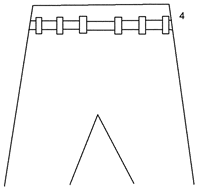 Sew belt loops around the waist, with the waist tie fed through these.
Sew belt loops around the waist, with the waist tie fed through these.
If you have enough fabric then it is better to cut the leg pieces 'on the cross' or 'on the bias' diagonally across the cloth - however this normally needs a lot more fabric and a lot more skill!
Single Leg Hose
The most common form of leg covering from the fifth to the thirteenth century seems to have been the single leg hose.
Although the exact cut of the hose varied over this time the basic garment remained the same. Whilst some people wore braies (long linen underpants) the poorer man would have worn his hose with just a loin cloth.
Hose were always made tight so as to hug the leg, and sometimes had a foot included and should be cut on the cross/ bias.
These drawings show hose typical of those worn in the tenth and eleventh centuries.
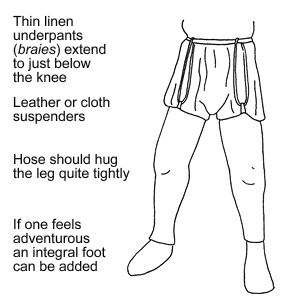
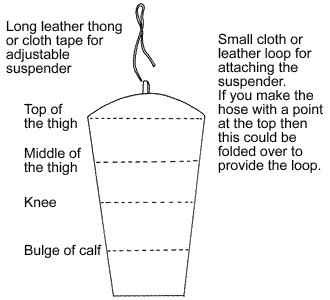
More Information
Remember that further information can be found in the Regia Library:
- Make Trousers Beginners (PDF)
- Hose Pattern (PNG)